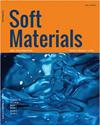具有抗氧化性能的无毒交联柠檬酸制备Anthraea mylitta丝胶水凝胶膜
IF 1.4
4区 材料科学
Q4 MATERIALS SCIENCE, MULTIDISCIPLINARY
引用次数: 0
摘要
丝胶蛋白是一种水溶性蛋白质生物聚合物,通常作为丝绸加工工业的副产品而被丢弃。然而,近年来丝胶大分子在生物材料制造中的应用越来越多。目前丝胶蛋白水凝胶制备的策略包括与戊二醛或吉尼平交联,这是已知的细胞毒性和阻碍/限制最终产品的生物应用。为此,研究了用无毒交联剂柠檬酸制备含聚乙二醇(PEG)和不含聚乙二醇(PEG)的柞蚕丝胶水凝胶膜。制备的水凝胶膜的生物物理表征证实了再生丝胶中天然丝的天然特性,以及在1709 cm−1处的AmSHF和峰的出现,表明水凝胶膜由于酯键的形成而发生交联,导致纳米级粗糙度为4.29 nm,无定形,膨胀比为18.76±0.058 g/g。抗氧化实验表明,丝胶蛋白的抗氧化性质在AmSHF形成后仍保持不变。AmSHF还被发现具有细胞相容性,并显著增加NIH3T3成纤维细胞的增殖。这些结果为使用这些水凝胶作为伤口愈合和皮肤组织再生的生物材料开辟了几种可能性。本文章由计算机程序翻译,如有差异,请以英文原文为准。
Fabrication of Antheraea mylitta sericin hydrogel film via non toxic crosslinking citric acid with antioxidant properties
ABSTRACT Sericin, a water-soluble protein biopolymer, is usually discarded as a byproduct of the silk processing industries. However, in recent years the applications of sericin biomacromolecule for biomaterial fabrication have increased. The current strategy of sericin hydrogel preparation involves crosslinking with glutaraldehyde or genipin which are known to be cytotoxic and hinder/restrict the biological applications of the end product. Therefore, citric acid, a nontoxic crosslinking agent, was explored for the fabrication of Antheraea mylitta sericin hydrogel films (AmSHF) with and without Polyethylene glycol (PEG). The biophysical characterization of fabricated hydrogel films confirmed the native properties of the natural silk in the regenerated sericin, as well as the AmSHF and appearance of the peak at 1709 cm−1, which indicated crosslinking of the hydrogel films due to the formation of ester bonds resulting in nanoscale roughness of 4.29 nm and amorphous nature with a higher swelling ratio of 18.76 ± 0.058 g/g. The antioxidant nature of sericin was retained even after AmSHF formation as revealed by antioxidant assays. The AmSHF were also found to be cytocompatible and significantly increased the proliferation of NIH3T3 fibroblast cells. These results open up several possibilities for using these hydrogels as a biomaterial for wound healing and skin tissue regeneration.
求助全文
通过发布文献求助,成功后即可免费获取论文全文。
去求助
来源期刊

Soft Materials
工程技术-材料科学:综合
CiteScore
2.90
自引率
0.00%
发文量
21
审稿时长
2.2 months
期刊介绍:
Providing a common forum for all soft matter scientists, Soft Materials covers theory, simulation, and experimental research in this rapidly expanding and interdisciplinary field. As soft materials are often at the heart of modern technologies, soft matter science has implications and applications in many areas ranging from biology to engineering.
Unlike many journals which focus primarily on individual classes of materials or particular applications, Soft Materials draw on all physical, chemical, materials science, and biological aspects of soft matter. Featured topics include polymers, biomacromolecules, colloids, membranes, Langmuir-Blodgett films, liquid crystals, granular matter, soft interfaces, complex fluids, surfactants, gels, nanomaterials, self-organization, supramolecular science, molecular recognition, soft glasses, amphiphiles, foams, and active matter.
Truly international in scope, Soft Materials contains original research, invited reviews, in-depth technical tutorials, and book reviews.
 求助内容:
求助内容: 应助结果提醒方式:
应助结果提醒方式:


